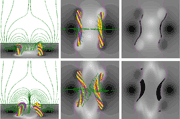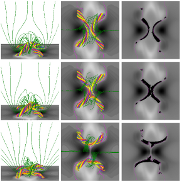
Filaments (or prominences) are large, sheet-like structures located in the solar atmosphere. They are about hundred times denser and cooler than the surrounding corona, and can reach heights of up to 100 Mm above the visible solar surface (the photosphere). The dense filament plasma is suspended against the Sun's gravity by magnetic forces. It is believed that the filament plasma accumulates in so-called dips, i.e., at locations where the magnetic field is locally horizontal and curved upwards. Large filaments can be stable over many days before they finally erupt (typically as part of a coronal mass ejection).
On 20 November 2003, an uncommon dynamic interaction between two elongated filaments could be observed in active region NOAA 10501 (Figure 1). Initially, the middle sections of the filaments were oriented in the north-south direction. At around 1:00 UT they started to approach each other. Between about 01:45 UT and 02:15 UT they came into contact, merged, and disconnected again. After this interaction, the middle sections of the filaments were oriented in the east-west direction, i.e., the filaments had exchanged their footpoint connections.
The morphological evolution of the filaments resembles the well-known pattern of two-dimensional reconnection between antiparallel magnetic field lines (Animation 1). It suggests that the magnetic field structures that carried the filament plasma (presumably flux ropes) were reconnecting with each other.
In order to test this scenario, we performed a 3D zero beta MHD simulation, using the coronal flux rope model by Titov and Démoulin (1999) as initial condition. We modified the model such that it contains two flux ropes oriented side-by-side and surrounded by an arcade-like potential field (Figure 2, top). The right panels in the figure show the distribution of field line dips, which we use to mimic the observed filaments. The topology of the potential field was chosen as suggested by the observation, i.e., with positive field (white) in the region between the flux ropes (filaments), and negative field (black) in the surrounding area. The magnetic orientation of the flux ropes was also guided by the observation, using the sign of flux in the regions where the observed filament footpoints were located.
Before pushing the ropes against each other to facilitate their reconnection, we first had to weaken the magnetic field between them (otherwise the pushing would have led to a strong pile-up of flux between the ropes hindering reconnection). This was done by imposing boundary flows that moved out the central positive (white) polarities from the region between the flux ropes. As a result of this weakening of the central flux, the middle sections of the flux ropes leaned towards the center, almost touching each other (Figure 2, bottom). Note the apparent widening of the model filaments. This is a projection effect, caused by the fact that the vertical, sheet-like layers of dips located within the flux ropes lean to the side as well.
After a second relaxation of the system, we applied converging flows at the bottom plane, such that the negative (black) potential field polarities were slowly moved towards each other (Figure 3). Since the field between the flux ropes has been sufficiently weakend by the first driving phase, the converging flows can bring the middle sections of the flux ropes into contact and press them against each other, so that they start to reconnect. Figure 3 shows snapshots during the reconnection. It can be seen that the flux ropes fully exchange their footpoint connections, forming two new distinct ropes. The flux rope dips follows this pattern (Figure 3, right panels). See also Animation 2 for the evolution duirng the whole simulation.
The morphological evolution of the simulated filaments is qualitatively equivalent to the observed evolution. Our simulation therefore supports the suggestion that the observed evolution can be explained by magnetic reconnection between two coronal flux ropes.
This work has been published in the Astrophysical Journal. See Török et al. (2011) for more details and further results.
For more details on the filament dynamics (and for a descriptions of the eruptive events that took place on the same day in the active region), see:
| @ |

|
T. Török, L. Van Driel, G. Valori, J.-M. Malherbe (Obs Paris) in collaboration with KU Leuven, HVAR, UNIGRAZ, UGOE |

|

|

|





